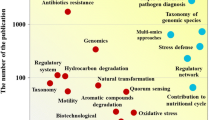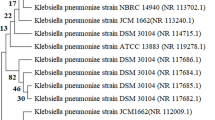Abstract
Constanta harbor has been contaminated for decades with petroleum and petroleum products, which contain different toxic organic solvents. A novel solvent-tolerant bacterium, Vibrio alginolyticus IBBCt2 was isolated from a seawater sample (Constanta harbor). Alkanes (i.e., n-hexane, n-decane, cyclohexane) with logarithm of partition coefficient in n-octanol and water (log P OW ) > 3.35, were less toxic for V. alginolyticus strain IBBCt2, compared with aromatics (i.e., toluene, m-xylene, ethylbenzene) with log P OW < 3.17. The high organic solvent resistance of V. alginolyticus IBBCt2 could be due to the presence of some catabolic (alkB, alkB/alkB1, todC1, xylM, C23DO) and transporter (HAE1, acrAB) genes. The adaptation mechanisms, underlying cyclohexane, n-hexane, n-decane, toluene, m-xylene, and ethylbenzene resistance in V. alginolyticus IBBCt2 showed a complex response of cells 60 min after solvent shock (i.e., modifications of the cell viability, changes in the membrane’s lipid and protein profile, modifications of the genomic fingerprinting). Exposure of V. alginolyticus IBBCt2 cells to salt stress decreases the organic solvents tolerance of this bacterium.

Similar content being viewed by others
References
Altschul, S. F., Gish, W., Miller, W., Myers, E. W., & Lipman, D. J. (1990). Basic local alignment search tool. Journal of Molecular Biology, 215, 403–410.
Baldwin, B. R., Nakatsu, C. H., & Nies, L. (2003). Detection and enumeration of aromatic oxygenase genes by multiplex and real-time PCR. Applied and Environmental Microbiology, 69, 3350–3358.
Bhattacharya, D., Sarma, P. M., Krishnan, S., Mishra, S., & Lal, B. (2003). Evaluation of genetic diversity among Pseudomonas citronellolis strains isolated from oily sludge-contaminated sites. Applied and Environmental Microbiology, 69, 1435–1441.
Bradford, M. M. (1976). A rapid and sensitive method for the quantitation of microgram quantities of protein utilizing the principle of protein-dye binding. Analytical Biochemistry, 72, 248–254.
Cruden, D. L., Wolfram, J. H., Rogers, R. D., & Gibson, D. T. (1992). Physiological properties of a Pseudomonas strain which grows with o-xylene in a two-phase (organic-aqueous) medium. Applied and Environmental Microbiology, 58, 2723–2729.
Díaz, E. (2004). Bacterial degradation of aromatic pollutants: a paradigm of metabolic versatility. International Microbiology, 7, 173–180.
Fischer, J., Schauer, F., & Heipieper, H. J. (2010). The trans/cis ratio of unsaturated fatty acids is not applicable as biomarker for environmental stress in case of long-term contaminated habitats. Applied Microbiology and Biotechnology, 87, 365–371.
Gupta, A., & Khare, S. K. (2009). Enzymes from solvent-tolerant microbes: Useful biocatalysts for non-aqueous enzymology. Critical Reviews in Biotechnology, 29, 44–54.
Hall, T. A. (1999). BioEdit: a user-friendly biological sequence alignment editor and analysis program for Windows 95/98/NT. Nucleic Acids Symposium Series, 41, 95–98.
Hedlund, B. P., & Staley, J. T. (2001). Vibrio cyclotrophicus sp. nov., a polycyclic aromatic hydrocarbon (PAH)-degrading marine bacterium. International Journal of Systematic and Evolutionary Microbiology, 51, 61–66.
Heipieper, H. J., Neumann, G., Cornelissen, S., & Meinhardt, F. (2007). Solvent-tolerant bacteria for biotransformations in two-phase fermentation systems. Applied Microbiology and Biotechnology, 74, 961–973.
Gutierrez, A., Elez, M., Clermont, O., Denamur, E., & Matic, I. (2011). Escherichia coli YafP protein modulates DNA damaging property of the nitroaromatic compounds. Nucleic Acids Research, 39, 4192–4201.
Inoue, A., & Horikoshi, K. (1989). A Pseudomonas thrives in high concentrations of toluene. Nature, 338, 264–266.
Jussila, M. M., Jurgens, G., Lindström, K., & Suominen, L. (2006). Genetic diversity of culturable bacteria in oil-contaminated rhizosphere of Galega orientalis. Environmental Pollution, 139, 244–257.
Kato, C., Inoue, A., & Horikoshi, K. (1996). Isolating and characterizing deep-sea marine microorganisms. Trends in Biotechnology, 14, 6–12.
Khmel, I. A. (2006). Quorum-sensing regulation of gene expression: fundamental and applied aspects and the role in bacterial communication. Microbiology, 75, 390–397.
Kohno, T., Sugimoto, Y., Sei, K., & Mori, K. (2002). Design of PCR primers and gene probes for general detection of alkane-degrading bacteria. Microbes and Environments, 17, 114–121.
Marchesi, J. R., Sato, T., Weightman, A. J., Martin, T. A., Fry, J. C., Hiom, S. J., & Wade, W. G. (1998). Design and evaluation of useful bacterium-specific PCR primers that amplify genes coding for bacterial 16 S rRNA. Applied and Environmental Microbiology, 64, 795–799.
Meguro, N., Kodama, Y., Gallegos, M. T., & Watanabe, K. (2005). Molecular characterization of resistance-nodulation-division transporters from solvent- and drug-resistant bacteria in petroleum-contaminated soil. Applied and Environmental Microbiology, 71, 580–586.
Mesarch, M. B., Nakatsu, C. H., & Nies, L. (2000). Development of catechol 2,3-dioxygenase-specific primers for monitoring bioremediation by competitive quantitative PCR. Applied and Environmental Microbiology, 66, 678–683.
Na, K. S., Kuroda, A., Takiguchi, N., Ikeda, T., Ohtake, H., & Kato, J. (2005). Isolation and characterization of benzene tolerant Rhodococcus opacus strains. Journal of Bioscience and Bioengineering, 99, 378–382.
Ogino, H., Uchiho, T., Yokoo, J., Kobayashi, R., Ichise, R., & Ishikawa, H. (2001). Role of intermolecular disulfide bonds of the organic solvent-stable PST-01 protease in its organic solvent stability. Applied and Environmental Microbiology, 67, 942–947.
Orphan, V. J., Hinrichs, K.-U., Ussler, W., III, Paull, C. K., Taylor, L. T., Sylva, S. P., Hayes, J. M., & Delong, E. F. (2001). Comparative analysis of methane-oxidizing archaea and sulfate-reducing bacteria in anoxic marine sediments. Applied and Environmental Microbiology, 67, 1922–1934.
Ramos, J. L., Duque, E., Gallegos, M. T., Godoy, P., Ramos-González, M. I., Rojas, A., Terán, W., & Segura, A. (2002). Mechanisms of solvent tolerance in gram-negative bacteria. Annual Review of Microbiology, 56, 743–768.
Ramos, J. L., Duque, E., Huertas, M. J., & Haídour, A. (1995). Isolation and expansion of the catabolic potential of a Pseudomonas putida strain able to grow in the presence of high concentrations of aromatic hydrocarbons. Journal of Bacteriology, 177, 3911–3916.
Sambrook, J., Fritsch, E. F., & Maniatis, T. (1989). Molecular Cloning, A Laboratory Manual (2nd ed.). Cold Spring Harbor: Cold Spring Harbor Laboratory Press.
Sardessai, Y. N., & Bhosle, S. (2004). Industrial potential of organic solvent tolerant bacteria. Biotechnology Progress, 20, 655–660.
Segura, A., Godoy, P., van Dillewijn, P., Hurtado, A., Arroyo, N., Santacruz, S., & Ramos, J. L. (2005). Proteomic analysis reveals the participation of energy- and stress-related proteins in the response of Pseudomonas putida DOT-T1E to toluene. Journal of Bacteriology, 187, 5937–5945.
Segura, A., Hurtado, A., Rivera, B., & Lăzăroaie, M. M. (2008). Isolation of new toluene-tolerant marine strains of bacteria and characterization of their solvent-tolerance properties. Journal of Applied Microbiology, 104, 1408–1416.
Sikkema, J., de Bont, J. A. M., & Poolman, B. (1995). Mechanisms of membrane toxicity of hydrocarbons. Microbiological Reviews, 59, 201–222.
Sipos, R., Székely, A. J., Palatinszky, M., Révész, S., Márialigeti, K., & Nikolausz, M. (2007). Effect of primer mismatch, annealing temperature and PCR cycle number on 16 S rRNA gene-targetting bacterial community analysis. FEMS Microbiology Ecology, 60, 341–350.
Stancu, M. M. (2011a). Effect of organic solvents on solvent-tolerant Aeromonas hydrophila IBBPo8 and Pseudomonas aeruginosa IBBPo10. Indian Journal of Biotechnology, 10, 352–361.
Stancu, M. M. (2011b). Mechanisms of solvent tolerance in marine bacteria. In: Proceedings of the 12th International Conference on Environmental Science and Technology (Lekkas T. D., ed.), Rhodes, Greece, A-1826–A-1833.
Sun, X., & Dennis, J. J. (2009). A novel insertion sequence derepresses efflux pump expression and preadapts Pseudomonas putida S12 for extreme solvent stress. Journal of Bacteriology, 191, 6773–6777.
Thumar, J. T., & Singh, S. P. (2009). Organic solvent tolerance of an alkaline protease from salt-tolerant alkaliphilic Streptomyces clavuligerus strain Mit-1. Journal of Industrial Microbiology and Biotechnology, 36, 211–218.
Tsukagoshi, N., & Aono, R. (2000). Entry into and release of solvents by Escherichia coli in an organic–aqueous two-liquid phase system and substrate specificity of the AcrAB–TolC solvent-extruding pump. Journal of Bacteriology, 182, 4803–4810.
Versalovic, J., Koueth, T., & Lupski, J. R. (1991). Distribution of repetitive DNA sequences in eubacteria and application to fingerprinting of bacterial genome. Nucleic Acids Research, 19, 6823–6831.
Versalovic, J., Schneider, M., de Brujin, F. J., & Lupski, J. R. (1994). Genomic fingerprinting of bacteria using repetitive sequence-based polymerase chain reaction. Methods in Molecular and Cellular Biology, 5, 25–40.
Volkers, R. J. M., de Jong, A. L., Hulst, A. G., van Baar, B. L. M., de Bont, J. A. M., & Wery, J. (2006). Chemostat-based proteomic analysis of toluene affected Pseudomonas putida S12. Environmental Microbiology, 8, 1674–1679.
Wan, M. H., Wu, B., Ren, W., & He, B. F. (2010). Screening, characterization, and cloning of a solvent-tolerant protease from Serratia marcescens MH6. Journal of Microbiology and Biotechnology, 20, 881–888.
Wei, S.-J. C., Desai, S. M., Harvey, R. G., & Weiss, S. B. (1984). Use of short DNA oligonucleotides for determination of DNA sequence modifications induced by benzo[a]pyrene diol epoxide. Proceedings of the National Academy of Sciences of the USA, 81, 5936–5940.
Whyte, L. G., Greer, C. W., & Inniss, W. E. (1996). Assessment of the biodegradation potential of psychrotrophic microorganisms. Canadian Journal of Microbiology, 42, 99–106.
Wright, A., & Olsen, R. H. (1994). Self-mobilization and organization of the genes encoding the toluene metabolic pathway of Pseudomonas mendocina KR1. Applied and Environmental Microbiology, 60, 235–242.
Acknowledgments
The study was funded by project no. RO1567-IBB05/2012 from the Institute of Biology Bucharest of Romanian Academy. The author is grateful to Ana Dinu for technical support.
Author information
Authors and Affiliations
Corresponding author
Rights and permissions
About this article
Cite this article
Stancu, M.M. Investigation of Organic Solvent Resistance Mechanisms in Vibrio alginolyticus IBBCt2 . Water Air Soil Pollut 223, 4495–4505 (2012). https://doi.org/10.1007/s11270-012-1212-7
Received:
Accepted:
Published:
Issue Date:
DOI: https://doi.org/10.1007/s11270-012-1212-7




